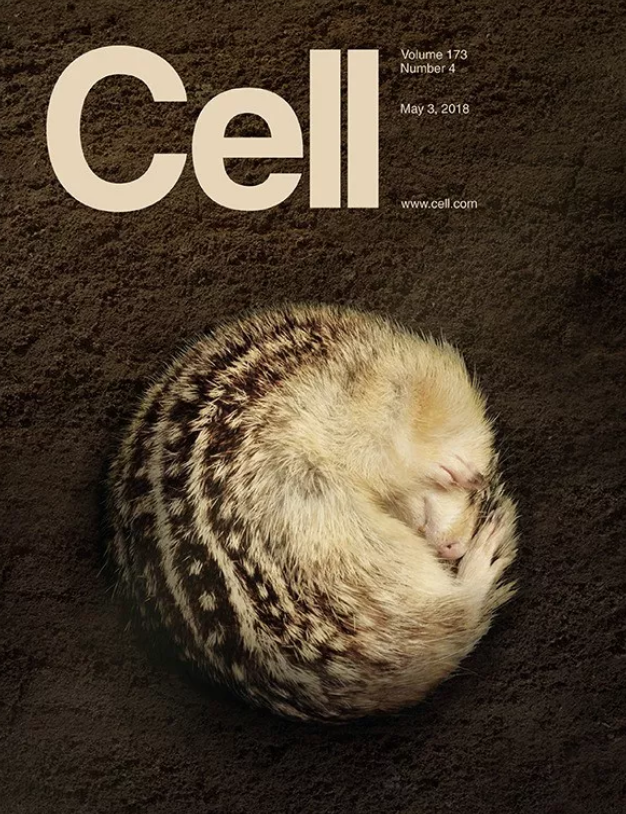Release date: 2018-05-08

â–² Dr. Wei Li, the author of this study (Source: Bryan William Jones; CC BY-NC 3.0; http://prometheus.med.utah.edu/~bwjones/)

â–²This research is on the cover of "Cell" (Source: "Cell")
Unlike the usual animal models of mice, zebrafish, and fruit flies, the researchers' main research object is a wonderful creature called 13-lined ground squirrels. These squirrels are studied because they are typical hibernating animals. In the cold winter, the animals can go to sleep, and the extremely low metabolism keeps their body temperature below 10 degrees.

â–²13-striped ground squirrel is a magical animal that can control body temperature for less than 10 degrees during hibernation (Source: Wikipedia public domain)
The cold tolerance of these squirrels has attracted the attention of researchers. You know, for animals that don't hibernate, such low body temperature is enough to cause serious damage to the organs. How do these squirrels do nothing after hibernation? If you can find the answer to this question, you may be able to get an important application in human clinical practice - for patients who need organ transplants, the kidneys or liver that can save their lives often need to be transported at low temperatures. If you can avoid the damage caused by low temperature to these organs, you may be able to improve the success rate of surgery.
At the beginning of the study, scientists first determined the principle of low temperature damage to cells. They found that in low temperature environments, the cytoskeleton of rats (non-hibernating animals) became fragmented, while the cytoskeleton of ground squirrels remained intact at low temperatures. This suggests that the integrity of the cytoskeleton may be the key to letting cells pass through low temperatures.
To better conduct research, scientists have created induced pluripotent stem cells (iPSCs) for ground squirrels in order to use them as an important tool for follow-up studies. One test showed that these stem cell-derived neurons had almost no difference in cold tolerance from normal neuronal cells. This also laid the foundation for subsequent research.

â–²Illustration of this study (Source: Cell)
With the help of stem cells, the follow-up study went quite smoothly. By comparing the cells of hibernating and non-hibernating animals, the scientists found that the gene expression profiles of the two were significantly different, and the pathways associated with mitochondrial function changed the most. Further exploration suggests that after cold, the level of ROS in normal animal cells will increase rapidly and dramatically, which is related to oxidative stress in cells. Scientists have concluded that it is because of the production of these ROS that they oxidize and destroy the integrity of the cytoskeleton.
This inference was quickly confirmed. The team then discovered that by introducing several drugs that act on this mechanism, even animals that are not hibernating can protect cells at low temperatures. This protective effect is more pronounced after the addition of protease inhibitors.
Specifically, only 4% of the rat retinal cells remained functional at 4 degrees of low temperature for treatment for 4 hours; in the treatment group, this figure was as high as 70%. Similarly, this method can effectively protect the kidneys stored at low temperatures, reduce potential side effects, and improve the success rate of transplantation.

â–² It is worth mentioning that two-thirds of this team is composed of Chinese scholars (Source: Cell)
As the team mentioned at the end of the paper, this new technology is expected to be widely used in human organs. It is estimated that in China alone, there are up to 2 million patients requiring organ transplants each year. Considering the vast territory of China, many organs have to undergo a low temperature treatment when transported to the operating table, which will have a certain impact on the function of the organs. If this new technology is feasible, it will undoubtedly minimize the effects of low temperatures.
From hibernating squirrels to new technologies to save lives, perhaps this is the charm of scientific transformation.
Reference materials:
[1] iPSCs from a Hibernator Provide a Platform for Studying Cold Adaptation and Its Potential Medical Applications
Source: Academic Jingwei
Digital 60m short range laser rangefinder is a laser measurement device which is supposed to replace tape measure, ruler, and other traditional length meauring tool. Laser ruler as its name, it is a electronic ruler which user laser to measure distance.
Our laser measurer has Multiply fuctions:
1. Height measure & Length measure &Distance measure
2. Area Measure
3. Volume Measure
4. Pythagorean Measure
60M Laser Measure,60M Laser Distance Measure,Laser Distance Measure Oem,60M Digitial Laser Distance Measure
Chengdu JRT Meter Technology Co., Ltd , https://www.jrt-measure.com